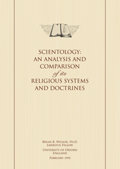IX.I. Academic Appraisals of What Constitutes Religion
Academic appraisal of what constitutes religion is ultimately based on observation of human behaviour: the observable phenomena provide the appropriate empirical evidence in deciding the indicia of religion as it is practised. The development of academic disciplines that are committed to objectivity, detachment, and ethical-neutrality, and the decline in influence of normative approaches (typically found in Theology) has provided new bases for the assessment of what constitutes religion.
IX.II. The Religious Status of Scientology
as Appraised by Academics
Academic sociologists, in whose field the objective study of religious movements falls, generally recognize Scientology as a religion. An essay on Scientology is included in Religious Movements in Contemporary America, edited by Irving I. Zaretsky and Mark P. Leone, (Englewood Cliffs, N.J.: Prentice-Hall, 1973), in which the author refers without question to Scientology as a religion. In a work edited by the British sociologist, Eileen Barker, Of Gods and Men: New Religious Movements in the West, (Macon, Georgia: Mercer University Press, 1983), Scientology is discussed unproblematically as a religion in three of four papers which devote attention to this particular movement. In the fourth paper (Participation Rates in New Religious and Para-religious Movements by Frederick Bird and William Reimer of Concordia University, Montreal), Scientology is referred to en passant as a new therapy movement and, implicitly, as a para-religious movement. However, the authors say of Scientology and some other groups that they had been included “because in their symbolism and ritual, in strikingly similar ways, they seek t0 give birth to a reservoir of sacred power within each person…”
In a short study devoted to sectarianism by the present writer, [Bryan Wilson, Religious Sects, (London: Weidenfeld; and New York, MacGraw Hill, 1970)] which presented a classification of types of sect, Scientology was included: I regarded it (and still regard it) as unquestionably a religious body. In that work, Scientology was classified as similar in sociological type to Christian Science, Theosophy, the Aetherius Society, and various New Thought movements (such as the Church of Religious Science, the Unity School of Christianity, and Divine Science).
In 1990, I published a book, The Social Dimensions of Sectarianism, (Oxford: Clarendon Press), a collection of studies of various sects and new religious movements. One chapter, entitled “Scientology: A Secularized Religion,” was specifically devoted to the question of whether Scientology could be considered to be a religion and concluded that Scientology should indeed be recognized as a religion, and one that embraced concepts and precepts that were congruent with contemporary secularized and rationalized society.
More recent sociological studies adopt the same stance. Thus, Dr. Peter Clarke, Director for the Centre for New Religions at King’s College, London, in assessing the size and growth of new religious movements in Europe, in his book The New Evangelists (London: Ethnographica, 1987), does not hesitate to include Scientology as a religion. In his book, Cult Controversies: Societal Responses to the New Religious Movements, (London: Tavistock, 1985), Professor James A. Beckford, now Professor of Sociology at the University of Warwick, employs—as a gesture to public preconceptions—the term “cult”, but he does so only after disavowing any pejorative connections in this usage. More important, however, is the fact that, without any qualification, he acknowledges Scientology to be a religion. He writes
IX.III. Is Scientology a Religion?—Professor Flinn
In a collection of scholarly papers edited by the Jesuit sociologist, Professor Joseph H. Fichter, S.J., of Loyola University, New Orleans, (Alternatives to American Mainline Churches, New York: Rose of Sharon Press, 1983), Frank K. Flinn, now Adjunct Professor in Religious Studies at Washington University, St. Louis, Missouri, addresses directly the question of the religious status of Scientology in great detail. He considers first the religious status of Dianetics:
Many commentators claim that Scientology is mental therapy masquerading as a religion. The crux of the question, however, is whether one can separate therapy from religion or even from philosophy by a hard-and-fast rule. The word therapeuo (to heal, cure, restore) occurs frequently in the New Testament, and refers to both spiritual and physical healings by Jesus of Nazareth…
While Dianetics had religious and spiritual tendencies, it was not yet a religion in the full sense of the term… Dianetics did not promise what may be called ‘transcendental’ rewards as the normal outcome of its therapy. It did, however, promise ‘trans-normal’ reward… Secondly, in the Dianetics stage of the movement, engrams were traced back to the fetal stage at the earliest… Thirdly, Dianetics had only four ‘dynamics’ or ‘urges for survival’—self, sex, group and Mankind… Fourthly, the auditing techniques in the Dianetics phase [did not use] the ‘E-Meter’.
There has been much debate as to when Scientology began to be a religion. One can point to the incorporation of the Hubbard Association of Scientologists in Phoenix, Arizona, in 1952, and then to the establishment of the Founding Church of Scientology in 1954. Legal incorporation, however, does not tell us when specifically religious concepts took shape in the church’s self-understanding. These debates, however, remind one of the nineteenth century disputes on when Christianity began: during Jesus’ life time? at Pentecost? through the ministry of Paul and the Apostles?
Flinn then considers the four factors outlined above in the transition from Dianetics to Scientology, noting that the first factor, the shift to transcendental goals, is marked by the shift from the goal of ‘Clear’ to the goal of establishing the ‘Operating Thetan’, and adds: “The concept ‘thetan’ no longer refers to a mental state but is analogous to the Christian concept of ‘spirit’ or ‘soul’ which is immortal and is above both brain and mind.”
Flinn adds this further comment:
The word religion is derived from religare which means ‘to bind back together’. This leads me to the broad definition of religion as a system of beliefs expressed in symbols which binds together the lives of individuals and/or groups, which issues in a set of religious practices (rituals), and which is sustained by an organised mode of life. The beliefs, practices and mode of life bind together the lives of people so as to give their existence ultimate meaning. While all religions have rudimentary elements of all three aspects, some, for example, stress the organizational system, or mode of life, over the belief system or the ritual practices. In Scientology, we see an example of a group that began with religious practices (the auditing techniques), soon developed a strong ecclesiastical structure, and only then formalised its belief system into a creed. This does not mean that the belief system was not latent in the earlier phases of the church’s evolution. It simply was not codified in a formal manner [in the way in which] the organizational technology was from the start.
By “strong ecclesiastical structure”, Flinn alludes to the general organisation of Scientology, its system of hierarchically arranged courses and auditing procedures.





























